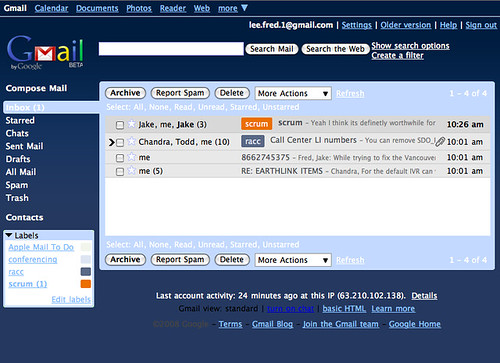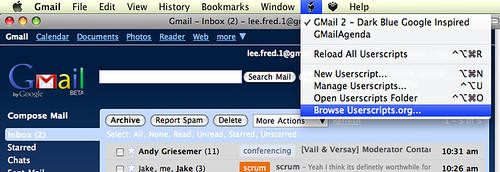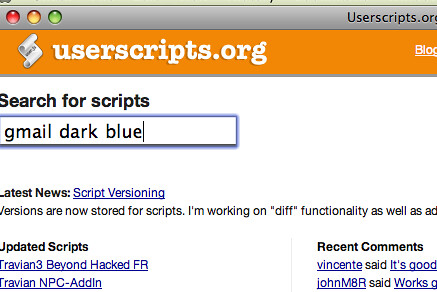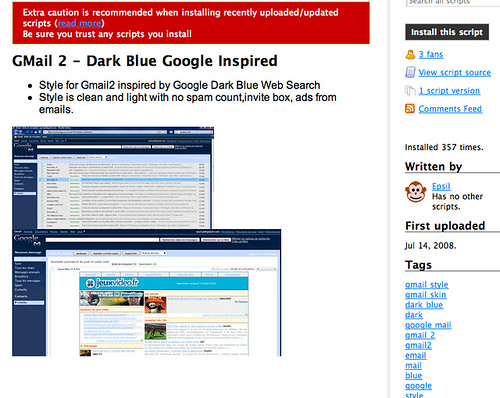If you are on Leopard and don't use Fluid, then get a clue. And, start using the awesomeness.
I love me some Gmail. I keep trying Apple Mail. But, I always end up back at Gmail.
So, try this to make your Gmail on Fluid even better.
My Fluid Gmail app looks like this:
I like the dark background, font, and NO ads!
To do this, follow these easy steps.
1. Create Gmail Fluid app.
2. Launch the Gmail Fluid app, not the Fluid app creator app.
3. Go to "Browse Userscript.org" in the menu bar.
4. Search for "gmail dark blue"
5. Click on "Gmail 2 - Dark Blue Google Inspired"
6. Install the script by clicking black "Install this script" button at the top of the left column.
7. Relaunch the Gmail Fluid app! Awesome!
Gmail with Fluid and this Script
Show & Tell Sessions
We have implemented what I am calling "Show & Tell Sessions".
Here are a few guidelines:
Teaching something is the best way to learn something. My hope is that these sessions will expand our knowledge.
Self-Training
A while back, I implemented "self-training" for my team. So far, I think it has been a success.
This is a mandatory task for the team. “Mandatory” as in it counts towards your performance. “Task” as in you do it. “Team” as in the team.
Here are the rules:
- Must do at least .5 hour per day
- Can not roll it over until you do it all in one day (i.e. 5 hours on Friday)
- You can use as many hours as you want towards a particular subject
- Any topic that is related to what we do is fair game
- If you want to buy a book or something, let me know. I will get it expensed.
- I can ask you to change it, expand it, or focus it if it seems like it does not accomplish number 5 or if you are spending too many hours on it.
So, Why? What's the point?
- To become more awesome
- To save Vail time and money
- To master your craft
I am sure that we all do some of this on our own. However, I wanted to structure it so that we will be accountable to one another for it. In other words, you can’t say you are learning something and not do it because one of us may ask you about it.
Some of the self-training subject matter will overlap with something you are assigned to do. For example, I don’t know much about implementing a central authentication systems. And, I want to implement it at Vail. I may self-train on it.
If that is the case, I would suggest approaching the self-training hour from an objective point of view.
“How does it work?” As opposed to, “How can I get it to work for Project xyz?”
It is a subtle difference and may not matter in practice. But, I don’t want to be biased in what we are learning towards some project timeline, or limitation.
In the end, it is all about being better. What we do is our craft. We should master it.
The Presenter Pattern - ActivePresenter for Rails
This is pretty sweet.
Rails strictly adheres to the MVC model . . . which is good. Where Rails falls a little bit short is when a view needs to manipulate multiple models. The out of the box Rails behavior is one model to one controller to one view.
But, in practice, you often have views that manipulate multiple models. Thankfully, because Rails is flexible, you can accomplish this in a number of ways. However, it often leads to inconsistent code structure, and fat controllers, or nearly untestable code.
What we needed was a “pattern”. I had heard about the presenter pattern last year at RailsEdge in Chicago. At the time, it was just a concept. I didn’t really get it.
Looking at this post (ActivePresenter), I get it now. And, its implementation is pure elegance. I can't wait to try it out.
RubyGems not updating properly
sudo gem update—systemcommand does not properly update rubygems. It will say that everything is up to date.
This has something to do with the way rubygems was installed on the machine. For example, if you installed rubygems with macports, it is possible that the macports package was slightly broken for this update procedure.
If this happens to you, you can still up date rubygems like this:
sudo gem install rubygems-update
sudo update_rubygems
Starting New
I have moved off of a Typepad account. I figured why pay for a blogging service. Yeah, I could have done some sort of data migration. But, there wasn't anything worth saving.
